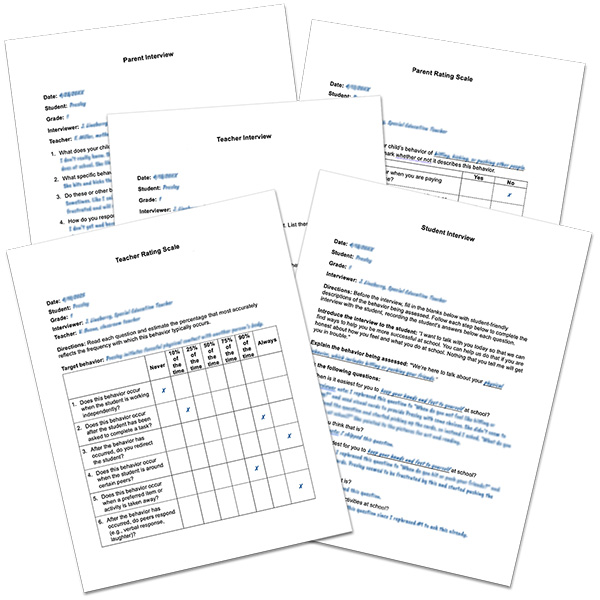How can educators determine why students are engaging in these behaviors?
Page 5: Indirect Assessments
 Once a target behavior has been operationally defined, the FBA team gathers comprehensive data to understand when, where, and how it occurs. The first type of data collected during an FBA comes from indirect assessments—assessments that do not involve firsthand observation of the target behavior. Instead, indirect assessments rely on individuals familiar with the student and their behavior (e.g., educators, family members, students) to report on their experiences and general observations.
Once a target behavior has been operationally defined, the FBA team gathers comprehensive data to understand when, where, and how it occurs. The first type of data collected during an FBA comes from indirect assessments—assessments that do not involve firsthand observation of the target behavior. Instead, indirect assessments rely on individuals familiar with the student and their behavior (e.g., educators, family members, students) to report on their experiences and general observations.
Indirect assessments can assist FBA teams with incorporating the perspectives and observations of multiple people. These assessments are relatively simple, quick to complete, and require minimal materials or tools. Although indirect assessments alone do not provide sufficient information about a behavior’s function, they can provide valuable details about its history and context. During an FBA, teams often conduct three types of indirect assessments: cumulative record reviews, structured interviews, and rating scales.
Cumulative Record Review
Did You Know?
Decades of research have shown that students are disproportionately subjected to exclusionary discipline (e.g., suspensions, expulsions) if they are:
- From minoritized racial or ethnic backgrounds
- Diagnosed with a disability
- Male
- From low socioeconomic backgrounds
As a result, disciplinary data must be critically examined to account for potential misperceptions and inequities.
Cumulative records of a student’s behavior and school performance can be a useful starting point in an FBA. These might include:
- Academic records
- Attendance records
- Disciplinary data
- Health history
- Progress monitoring data
x
progress monitoring
in glossary
- Evaluation results (e.g., psychological testing, speech or language assessments, adaptive behavior ratings)
x
adaptive behavior
in glossary
- IEP or 504 plan
- Previous FBAs or behavioral intervention plans (BIPs)
x
behavioral intervention plan (BIP)
in glossary
Such information could point to underlying factors influencing the student’s behavior (e.g., medical conditions, family circumstances, academic skill deficits). Educational records might reveal other patterns, such as when or where the target behavior has occurred or what consequences have reinforced it in the past. If a student has received behavioral interventions through MTSS, an IEP, or a BIP, educators should review the effectiveness of any previously implemented strategies. This information can help FBA teams uncover possible clues to understanding the current target behavior’s function. Nevertheless, when reviewing historical data, teams must always remember that behavior can change as a student grows older and interacts with new educators in novel learning environments. Behavior can also be impacted by changes in family dynamics or personal circumstances.
For Your Information
In most cases, students whose interfering behavior warrants an FBA have already been receiving targeted behavioral interventions. In schools that implement MTSS, these Tier 2 interventions should be accompanied by frequent and consistent collection of progress monitoring data. Because such data illustrate the student’s behavior over time and in response to targeted interventions, they are very useful to review as part of an FBA. Educators should continue implementing interventions and monitoring progress throughout the FBA data collection process.
Structured Interviews
Structured interviews are guided conversations with educators, family members, or the student that include questions to understand:
- Background information about the target behavior
- Possible antecedents and consequences associated with the target behavior
- Times of day, places, and activities in which the target behavior is likely to occur (as well as when and where it does not occur)
- Intervention strategies that have been implemented
Did You Know?
Interviews are not just about gathering information. When conducted thoughtfully, respectfully, and empathetically, interviews can also be used as a way to develop trust and foster positive relationships.
Structured interviews can usually be completed in about ten to thirty minutes and are typically conducted by the FBA team leader. They should prioritize open-ended questions that invite the respondent to describe and elaborate on their knowledge of the student and their behavior. Closed-ended questions that elicit yes–no answers provide limited information in comparison. Interviewers should always ensure that questions are culturally sensitive and respectful of the student’s and respondent’s backgrounds. Additionally, the interview should be conducted in a language that the respondent is comfortable communicating in with the support of a trained interpreter when appropriate.
Adult Interviews: FBA teams should seek multiple perspectives by interviewing adults who regularly interact with the student in different contexts and can provide insight into the student’s behavior. This could include school staff such as general or special education teachers, specialty/elective teachers (e.g., art, music), paraeducators, administrators, school counselors, or extracurricular personnel (e.g., coaches, club leaders, after-school staff). Interviewing parents and other family members can give further insight into the student’s behavior at home and in the community. Notably, interviews do not need to be restricted to people who regularly see the student’s target behavior. In fact, teams can often learn a great deal from hearing about when and where the behavior does not typically occur.
Student Interviews: FBA teams should also interview the student to seek their perspective on their own behavior and what they need to be successful. When interviewing a student, the educator should prepare them for the conversation by explaining its purpose in student-friendly terms. The interview should be individualized based on factors like the student’s self-awareness, language skills, developmental level, and cultural background. Educators can consider adaptations such as:
- Reducing the number of questions
- Simplifying the language used in questions
- Allowing students to select rather than generate responses (e.g., multiple choice, pointing to pictures)
- Incorporating visuals, stories, or role play
If the student displays signs of distress or behavioral escalation, the interview should be stopped immediately. Before attempting the interview again, the FBA team should reconsider necessary adaptations to increase the likelihood of the student participating safely and productively.
In this interview, Bettie Ray Butler discusses the importance of capturing the unique perspectives of families and students. Next, Mary-Austin Modic offers advice on making students and their families feel comfortable during structured interviews.

Bettie Ray Butler, PhD
Professor of Urban Education
University of North Carolina at Charlotte
(time: 1:40)
Transcript: Bettie Ray Butler, PhD
One key aspect of being culturally responsive is the integration of school and home culture. And so it’s important to collect the data in a way that’s bidirectional and collaborative—coconstruction with parents. Parents are experts of their own children. And so seeing them as an expert in the data collection process—I call them coresearchers—is an appropriate way to build the data.
So there may be things that are happening at the school that may not necessarily show up in the home. So that may mean that there’s something that’s triggering this child in the school environment. Or there may be instances where it shows up in the school and it’s showing up in the home, but how the school is responding to it is very different than how the parents and the families are responding to it. And whereas the families may be yielding a positive, more favorable outcome and the school is not, that’s when the school can yield to the expertise of the parents in terms of how to approach or what to do about the behavior.
The intentionality of integrating the student’s and the parents’ and the families’ voices is critical because if they are not included in these conversations, it heightens the chances that there is going to be something that is misinterpreted, some critical piece of information that gets lost. So the parents and families must be included.
Transcript: Mary-Austin Modic, BCBA, LBA
Educators can help students feel comfortable talking about their behavior, number one building rapport with the student. I’m not going to pull them the first time I meet them to do an interview or talk about challenging behaviors. I’m going to try to spend time with them in a positive environment—whether that’s go to gym class with them, maybe pull them to play a game—just so that I’m first not a stranger to them, and then also they’re associating me with positive activities, positive conversations.
And then number two, when I do the interview with a student, I usually try to focus on the positives first, and then come in with the more difficult questions around where the student is struggling or what behavior they’re struggling with. And then I always also try to be really considerate of my tone, my facial expressions so the student doesn’t ever feel like there’s any judgment or anything they say is shocking or upsetting to me. So always having positive regard for the student, no matter what they’re saying or what they’re describing.
I think, especially with the students, if I get in the room and I start it and the student might just not be in the mood or they might be distracted, I’m not afraid to stop it and come back to it later when the student might be more talkative or might have more information to share. So a lot of it, too, is sort of working around their mood because sometimes they might be willing to open up and other times you’ll just get yes or no answers.
I actually was doing one earlier this week and the student presented fine when I pulled her from the classroom, but then when we got down to some of the questions, it was very “Yes, no, I don’t know” and just very short, quick answers, so I stopped asking questions and just made it more like a casual time with the student. I took her back to class, and then the next day I pulled her again and I got much more detailed information on “What is hard about math class for you?” And she was able to go into more detail, where the day before it was “I don’t know. I just don’t like it.”
Educators can help parents feel comfortable talking about their child’s behavior also trying to bridge the values and the relationships from home to school. And you do that learning about the family and building rapport. What are their values? What is most important to them? It might not be that Johnny gets straight A’s. It might be that he makes it through the school day without getting sent home or getting a negative note home. So, I think the first step is the rapport building and figuring out what they value. What do we need here at school? And how can we come together to support each other in that? So really trying to get the parents to feel that we’re all on the same team and we’re all working together.
Research Shows
In a study of 10 high school students with disabilities who displayed interfering behaviors, students who participated in interviews as a part of their FBA were able to contribute accurate information about their behaviors and the antecedents and consequences they experienced. All students shared at least one piece of information that was unique from their teachers’ perspectives, suggesting that student input can help ensure a complete picture of the student’s needs.
(Chan et al., 2021)
Rating Scales
Rating scales are useful for recognizing common antecedents, consequences, and possible functions of the target behavior, particularly when comparing responses across multiple people. These tools include a set of questions or statements to which parents, educators, or the student respond on a designated scale (e.g., 1–5; never, sometimes, often, always; yes/no). Respondents might be asked to gauge how often the target behavior occurs in certain settings, follows certain events, or results in a certain outcome.
Keep in Mind
FBA teams must be aware of the limitations of indirect assessments. Such data are subjective and can reflect a respondent’s misperceptions about a student’s behavior. Because information is collected after the fact, a respondent also could express inaccurate or exaggerated memories of behavioral events. Therefore, conclusions should not be drawn from indirect assessment results alone.
Returning to the Challenge

DJ’s FBA team collects information from multiple people using behavior rating scales and structured interviews. The forms below include portions of this data.

Likewise, Presley’s FBA team utilizes indirect assessment data from multiple sources to better understand her target behavior. The forms below include portions of this data.
